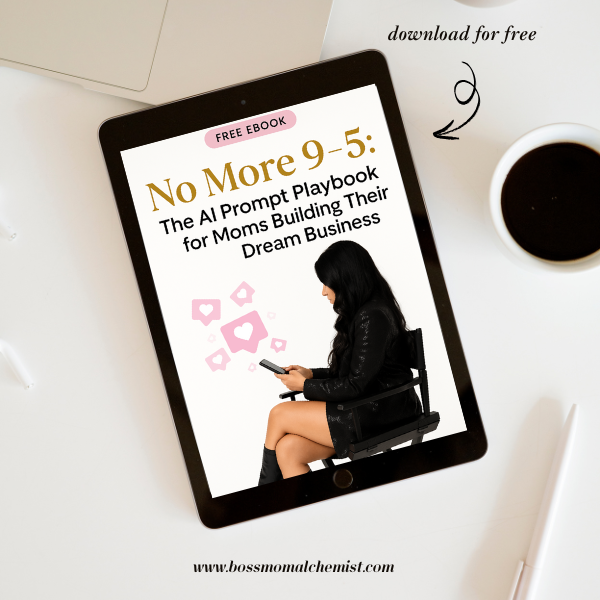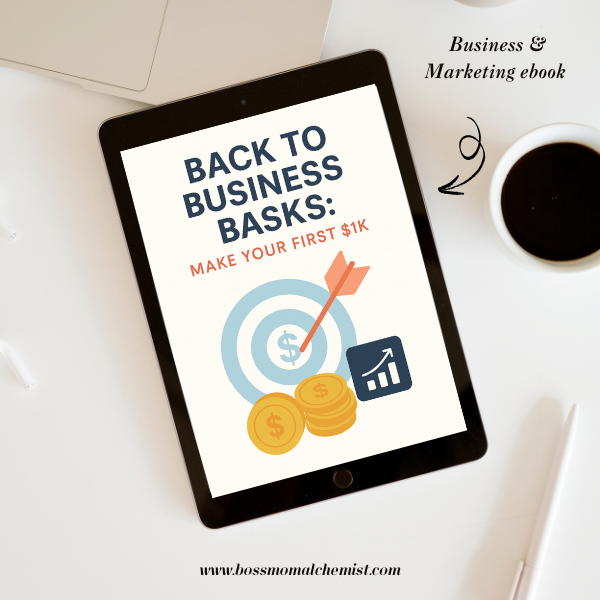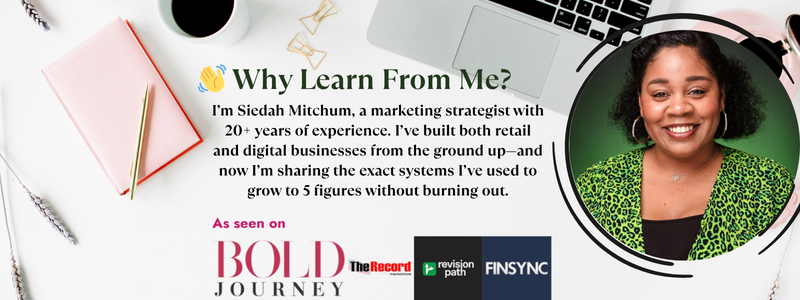
“Passion is a spark—but systems build the fire.”
Every day in Facebook groups, I see the same question pop up:
“I want to make extra income every month… what side hustle should I start?”
And like clockwork, someone replies, “Follow your passion.”
But here’s the truth no one talks about: passion is not a business plan.
In 2025, if you want to grow your small business quickly, you need more than enthusiasm—you need structure, systems, and a plan that aligns with what the market actually wants.
When I started my first business, I followed my passion for design. I loved creating beautiful websites. That passion turned into a skill-based business that made real money because it met a need people were willing to pay for. My second business was product-based. I sold crystals, crystal jewelry, and candles—alongside my self-published book. Those products sold because they offered transformation, not just aesthetics.
And that’s the key: your business must serve a purpose in the marketplace.
Let’s break down the five steps that will help you grow your small business quickly in 2025—without burning out or guessing your next move.
Step 1: Test and Validate Your Business Idea
Before you invest in logos, websites, or inventory, you need proof of concept.
In other words: can this idea make money?
If you’re reading this, chances are you already have a few ideas—maybe something you’re passionate about, or a skill you could turn into income. But the mistake most new entrepreneurs make is assuming passion alone equals profit.
Here’s what to do instead:
-
Start with your skill or experience.
What do people already ask you for help with? What results have you gotten for yourself or others? That’s your starting point. -
Research your market.
Search on Etsy, Amazon, or Google to see if people are already paying for similar products or services.-
What are they charging?
-
How are they packaging their offers?
-
What pain points are customers mentioning in reviews?
-
-
Create a simple test offer.
You don’t need a full business plan to start. Try selling a mini version of your idea—a one-hour consultation, a single product, or a small digital download. -
Track your results.
The data will tell you everything. If people buy quickly or ask for more, you’re onto something. If not, tweak your messaging or offer.
💡 Pro Tip: Don’t wait for perfection. Your goal in this stage is sales validation, not brand perfection.
Remember: if your idea doesn’t generate sales, it’s not a business—it’s a hobby.
Step 2: Register Your Business Properly
Once you’ve made consistent sales and validated your idea, it’s time to make it official.
Formalizing your business opens doors to business funding, wholesale accounts, partnerships, and brand credibility.
Here’s a simplified breakdown of how to do it:
1️⃣ Register a DBA (Doing Business As)
If you’re using a business name different from your personal name, file a DBA with your county or state.
-
This legally ties your chosen business name to you.
-
You can often file online for under $50.
2️⃣ Get an EIN (Employer Identification Number)
Head to the IRS website to obtain a free EIN.
-
Think of it as a Social Security Number for your business.
-
You’ll need it to open a business bank account, apply for credit, or work with vendors.
3️⃣ Open a Business Bank Account
Keep your business and personal finances separate from day one.
-
Choose a bank that offers small business perks or integrations with bookkeeping apps.
-
Deposit your sales income and pay expenses from this account only.
4️⃣ Form an LLC (Limited Liability Company)
Once you start making consistent income, consider upgrading to an LLC.
This protects your personal assets if anything ever goes wrong and adds credibility to your brand.
-
Check your state’s Secretary of State website for exact steps and fees.
-
Many states allow online filing in under an hour.
✅ Bonus: Registering your business early positions you to access business funding, credit cards, and tax deductions—essential for growth in 2025.
Step 3: Start Email Marketing Early
This is where most new entrepreneurs miss the mark.
They focus on building a website, when what they really need is a way to collect leads and build trust.
An email list is the foundation of every successful business—especially in 2025, when algorithms change daily and organic reach keeps dropping.
Here’s how to start:
-
Choose an email marketing platform.
Start with easy tools like Mailchimp, MailerLite, or Constant Contact—they’re beginner-friendly and allow automation. -
Create a simple landing page.
Skip the fancy website for now. Your landing page should:-
Introduce your business
-
Offer a valuable freebie (like a guide, checklist, or mini training)
-
Capture emails in exchange for the freebie
-
-
Build your welcome sequence.
Create 3–5 automated emails that introduce your story, your offer, and the transformation your business provides. -
Send weekly emails.
Share value, not just sales pitches.-
Teach something useful
-
Tell stories from your journey
-
Give behind-the-scenes insight into your products or process
-
💡 Pro Tip: Focus on relationship-building. People buy from brands they trust and recognize.
If you can build a list of 100 engaged subscribers, that’s worth more than 10,000 social media followers who never buy.
Step 4: Create a Marketing Plan and Budget
Now that your business is set up and you’re collecting leads, it’s time to attract traffic—the lifeblood of your business.
Without marketing, no one knows you exist. Without a budget, your growth remains inconsistent.
Build a Simple Marketing Plan:
-
Know your target audience.
Define your ideal customer: their age, interests, pain points, and where they hang out online. -
Choose 2–3 marketing channels.
You don’t need to be everywhere. Start where your customers are:-
Instagram or Facebook for visual products
-
Pinterest and blogs for long-term organic traffic
-
YouTube or TikTok for storytelling and tutorials
-
-
Set a marketing budget.
Even $100–$200/month can go a long way when spent strategically.
Examples:-
$50 for ads promoting your freebie
-
$30 for Canva Pro
-
$20 for email marketing software
-
$100 for tools or education
-
-
Track what’s working.
Use free tools like Google Analytics and Meta Insights to measure clicks, conversions, and sales. -
Focus on consistency over virality.
The brands that win in 2025 will be those that show up weekly—not just when motivation hits.
💡 Pro Tip: Batch-create your content for the month using ChatGPT or Canva. Schedule posts, emails, and pins in advance to stay consistent even when life gets busy.
Step 5: Build a System That Sells for You
Once you’ve nailed your offer, audience, and marketing plan, it’s time to build the system that allows you to scale—without doing everything manually.
A system bridges the gap between awareness and conversion. It turns strangers into subscribers, and subscribers into loyal customers.
Here’s what a simple sales system looks like:
-
Traffic Source → Landing Page
Use social media or ads to drive traffic to your free offer. -
Landing Page → Email Sequence
Offer a freebie (e.g., checklist, mini ebook, or guide) to build your list. -
Email Sequence → Paid Offer
Introduce your story and solution through emails that lead naturally to your paid product or service. -
Automation → Analytics
Automate your emails and track what people click or open most. Use that data to improve your messaging.
This system does the heavy lifting for you.
Even while you’re busy or offline, your funnel keeps attracting leads and nurturing them toward your offer.
Example:
When I sold my first ebook, I paired it with crystal candles and crystal jewelry. Every sale came through an email funnel that introduced me, shared why I created the product, and offered a special discount. That funnel brought consistent sales—long after my initial post went live.
💡 Pro Tip: Your system doesn’t need to be complicated. One simple funnel—done right—can generate steady income month after month.
Final Thoughts
Growing a small business in 2025 isn’t about overnight success or chasing trends.
It’s about building something that works without you being glued to your phone 24/7.
When you:
✅ Test your idea
✅ Register your business
✅ Build your email list
✅ Create a marketing plan
✅ Develop a simple system
You create the foundation for freedom—not just sales.
Because the truth is: you don’t need to hustle harder. You just need the right structure.
Start small. Start smart. And remember:
“Passion may light the match, but systems keep the fire burning.”






Leave a Reply